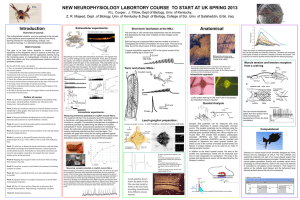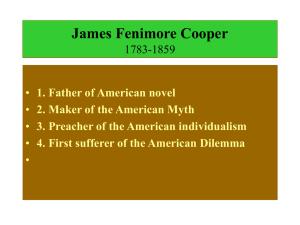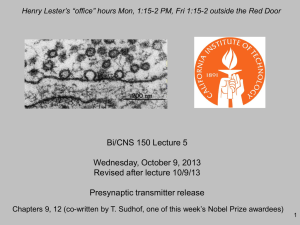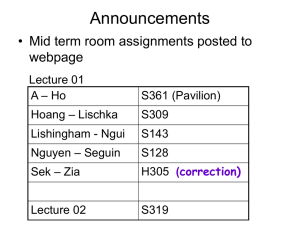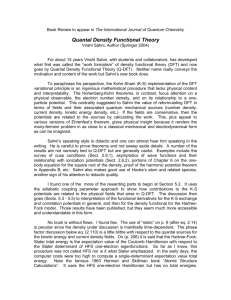MS word
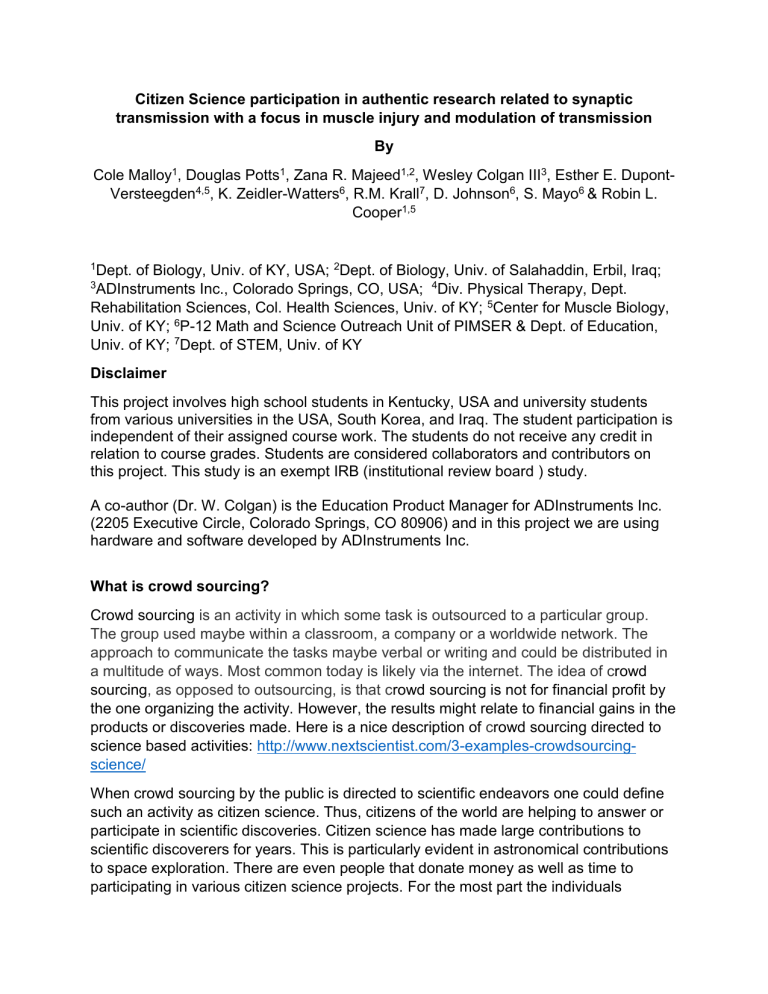
Citizen Science participation in authentic research related to synaptic transmission with a focus in muscle injury and modulation of transmission
By
Cole Malloy 1 , Douglas Potts 1 , Zana R. Majeed 1,2 , Wesley Colgan III 3 , Esther E. Dupont-
Versteegden 4,5 , K. Zeidler-Watters 6 , R.M. Krall 7 , D. Johnson 6 , S. Mayo 6 & Robin L.
Cooper 1,5
1 Dept. of Biology, Univ. of KY, USA; 2 Dept. of Biology, Univ. of Salahaddin, Erbil, Iraq;
3 ADInstruments Inc., Colorado Springs, CO, USA; 4 Div. Physical Therapy, Dept.
Rehabilitation Sciences, Col. Health Sciences, Univ. of KY; 5 Center for Muscle Biology,
Univ. of KY; 6 P-12 Math and Science Outreach Unit of PIMSER & Dept. of Education,
Univ. of KY; 7 Dept. of STEM, Univ. of KY
Disclaimer
This project involves high school students in Kentucky, USA and university students from various universities in the USA, South Korea, and Iraq. The student participation is independent of their assigned course work. The students do not receive any credit in relation to course grades. Students are considered collaborators and contributors on this project. This study is an exempt IRB (institutional review board ) study.
A co-author (Dr. W. Colgan) is the Education Product Manager for ADInstruments Inc.
(2205 Executive Circle, Colorado Springs, CO 80906) and in this project we are using hardware and software developed by ADInstruments Inc.
What is crowd sourcing?
Crowd sourcing is an activity in which some task is outsourced to a particular group.
The group used maybe within a classroom, a company or a worldwide network. The approach to communicate the tasks maybe verbal or writing and could be distributed in a multitude of ways. Most common today is likely via the internet. The idea of c rowd sourcing , as opposed to outsourcing, is that c rowd sourcing is not for financial profit by the one organizing the activity. However, the results might relate to financial gains in the products or discoveries made. Here is a nice description of c rowd sourcing directed to science based activities: http://www.nextscientist.com/3-examples-crowdsourcingscience/
When crowd sourcing by the public is directed to scientific endeavors one could define such an activity as citizen science. Thus, citizens of the world are helping to answer or participate in scientific discoveries. Citizen science has made large contributions to scientific discoverers for years. This is particularly evident in astronomical contributions to space exploration. There are even people that donate money as well as time to participating in various citizen science projects. For the most part the individuals
participating in citizen science projects are not paid financially but have the pleasure of knowing they are contributing to scientific advancement.
Check out these web pages or helping to obtain funds for a citizen science projects: https://www.kickstarter.com/hello?ref=nav
Citizen science
There are a nu mber of projects that fall under the term “Citizen Science” which are taking place. With a quick Google search one will find projects from solving 3diminsioanl structures of proteins to ornithological research. Participating in archeological discovers on trips organized with various organizations and universities to help archeologists with their time consuming tasks of exposing various structures and artifacts has been on going for some time
( http://www.nps.gov/archeology/Public/archvol.htm
; http://earthwatch.org/ ) . A reason for some to not participate in these exciting adventures is the associated costs for traveling to some of these remote locations and the physical activity. The concept of citizen science has been around since bird counts started in 1900’s with the annual activity orchestrated by the National Audubon Society (Tratmann et al., 2013, p.1) but now the opportunity to participate on a global scale with web based activities increases the ability of many more people to participate at relatively little cost. Elderly and/or physically handicapped people who can travel to participate can readily have a role in web based citizen science activities.
Goal of this project
The goal here is to have the public and interested parties participate in data analysis of synaptic transmission which will help answer related research questions. A hope is also that novel methodological approaches will be forthcoming and interpretations of the results can be shared for various researchers to benefit.
The learning objective of this laboratory is to be able observe and measure quantal synaptic vesicular release of neurotransmitter at the crayfish neuromuscular junction (NMJ). In addition an objective is to have citizens participate in authentic scientific data gathering and help to improve the methods for this citizen science project.
The primary data is obtained in one lab and then posted on line for participants to download. The synaptic responses are experimentally recorded when a motor nerve is electrically stimulating for inducing evoked responses. Spontaneous vesicular events are also recorded in the absence of stimulation or between evoked stimulations. The participants estimate means quantal content with three different approaches direct counts, amplitude measurements, and charge (area) measurements.
Background of synaptic transmission
During signal transmission throughout the nervous system, neurotransmitters are released into the synapses in order to transmit signals to targets. Neurotransmitters are released from the pre-synaptic terminal in a quantal manner, meaning that transmitter is
released in packets of neurotransmitter from a single vesicle at a time. The fusion of presynaptic vesicles in quantal transmitter packets relays the signal to the receptors on the postsynaptic membrane, where a graded current and potential can be measured as a result. The quantal vesicular responses can be measured either as spontaneous or evoked events. The evoked events occur when the nerve is stimulated in order to provide a measurable response within a defined period of time. The spontaneous events are random in nature and are generally seen as events induced by the fusion of a single vesicle. It is important to index quantal vesicular release in order to further understand the mechanisms underlying the process of synaptic transmission and to note changes with alterations in physiological and pathological processes.
There are a variety of methods for indexing synaptic transmission by quantal events. One such method is the direct counting of evoked quantal events. This method is the most useful when the evoked events are of a low probability of occurrence so multi-quantal events are low in occurrence. This allows a better accuracy in distinguishing the evoked quanta. Two other methods to quantify synaptic transmission is to estimate mean quantal content by measuring the amplitude of both evoked and spontaneous responses and estimate a mean quantal content or to measure the charge, or area in the recorded traces, of both spontaneous and evoked response events. The method of using charge to measure quantal synaptic responses is the preferred method for mammalian synapses or high output synapses because it appears to have less error associated with the measurements. Overall, using the three methods to index quantal transmission allows for comparison among the different approaches in order to determine which are the most useful. Quantifying the quantal synaptic output at the crayfish neuromuscular junctions is helpful for this exercise as high output and low output terminals can be examined in one preparation and various conditions
(frequency of stimulation, environmental changes such as temperature or alterations in ionic composition of the bathing solution). In addition, predictions and inquiry into where alterations occur in the presynaptic or postsynaptic components of transmission can be investigated. Discussion into what potentially gives rise to the variation in the single quantal events observed in spontaneous events is a topic that addresses the pre- and post-synaptic contributions to the quantal response.
Background of crayfish neuromuscular junction
The crayfish leg extensor muscle is mixed with some terminals being tonic (slow) and others phasic (fast) in their synaptic phenotypes (Wu and Cooper, 2013). The opener muscle of the walking legs are of a tonic type but still show variation depending on the muscle fibers they innervate as well as along the length of the terminal.
The NMJs on the opener muscle is well established as a model synaptic preparation for investigations of facilitation and presynaptic inhibition (Dudel and
Kuffler,1961a,b; Dudel, 1963, 1965a). The quantal responses of synaptic transmission at this NMJ has been investigated for various reasons (Dudel and Kuffler,1961a) but there are many novel experiments still waiting to be conducted. For a recent review of this model preparation please see Cooper and Cooper (2009).
The NMJs of the crayfish are easily accessed and they remain healthy for hours in a minimal saline solution, which allows them to be ideal for investigations into synaptic transmission. Many of the crayfish NMJs are non-spiking excitatory postsynaptic potentials (EPSP) such as the graded postsynaptic signals in dendrites within the mammalian CNS or the subthreshold potentials in vertebrate NMJs (Wiersma
& Van Harreveld, 1938; Katz & Kuffler, 1946). The NMJs of crayfish have served as fundamental model for synaptic transmission for a number of years (Atwood, 1982;
Cooper & Cooper, 2009; Fatt & Katz, 1953; Wu & Cooper, 2010).
The differences in synaptic structural complexity for phasic and tonic NMJ can in part account for the differences in synaptic efficacy. The number active zones on synapses and differences in Ca 2+ influx can account for some of the presynaptic differences between the types of terminals (Bradacs et al., 1997; Johnstone et al., 2008;
King et al., 1996; Lancaster et al., 2007; Miller et al, 2002; Viele et al., 2003, 2006). The vesicles pools between phasic and tonic nerve terminals appear to be regulated differentially in kinetics and in their susceptibility to the neuromodulator serotonin
(Cooper et al., 2003; Logsdon et al., 2006; Sparks and Cooper, 2004; Wu & Cooper,
2012, 2013).
As for postsynaptic differences in the receptor density and glutamate receptor subtypes of phasic and tonic NMJs, these topics have not been fully addressed in the crayfish synaptic models. To gain an understanding of pre- and post-synaptic contributions to synaptic efficacy one approach is to investigate the quantal unit and the quantal characteristics in various experimental conditions. Understanding of the fundamental differences in the physiology of different types of synapses on a comparative base enriches our understanding in the diversity of synaptic responses as well as commonalities.
The NMJs of accessible terminals on muscle fibers will be used to investigate quantal properties in synaptic transmission. As for experimental paradigms one can examine the influence of neuromodulators and various concentrations of Ca 2+ in the extracellular fluid on synaptic transmission in these preparations. Synaptic transmission can be assessed over regions of the various nerve terminals with a loose patch electrode (focal macropatch). Thus, a subset of the terminal will be monitored for synaptic transmission by recording spontaneous and evoked quantal events.
Background of Drosophila neuromuscular junction
The Drosophila melanogaster is a true model organism with a known genome and heavily used for addressing synaptic properties. The pharmacological and physiology of the NMJs associated with the larval m6 and m7 muscles are the terminals most commonly investigated (Atwood et al., 1993; Betz et al., 1993; Jan and Jan 1976;
Kurdyak et al., 1994; Lee et al., 2009; Li et al., 2002; Li and Cooper, 2001; Pawlu et al.,
2004; Ruffner et al., 1999; Sigrist et al., 2002, 2003; Stewart et al.,1994, 1996). As with the crayfish NMJs, the Drosophila postsynaptic receptors are glutamatergic and are of a
quisqualate receptor subtype (Bhatt and Cooper, 2005; Lee et al., 2009; Shinozaki and
Ishida, 1981; Shinozaki and Shibuya, 1974).
The quantal responses can be recorded in the same manner as at the crayfish
NMJs with a macropatch focal electrode (Cooper et al., 1995a,b).
Why quantal analysis?
There are a variety of methods for indexing synaptic transmission by quantal events. One such method is the direct counting of evoked quantal events. This method is the most useful when the evoked events are of a low probability of occurrence so multi-quantal events are low in occurrence. This allows a better accuracy in distinguishing the evoked quanta. Two other methods to quantify synaptic transmission is to estimate mean quantal content for a given stimulation paradigm. One approach is measuring the amplitude of both evoked and spontaneous responses and estimate mean quantal content. The other method is to measure the charge, or area in the recorded traces, of both spontaneous and evoked response events. The method of using charge to measure quantal synaptic responses is the preferred method for mammalian synapses or high output synapses because it appears have less error associated with the measurements. Overall, using the three methods to index quantal transmission allows for comparison among the different approaches in order to determine which are the most useful. Quantifying the quantal synaptic output at the crayfish neuromuscular junctions is helpful for this exercise as high output and low output terminals can be examined in one preparation and various conditions (frequency of stimulation, environmental changes such as temperature or alterations in ionic composition of the bathing solution). In addition, predictions and inquiry into where alterations occur in the presynaptic or postsynaptic components of transmission can be investigated. Discussion into what potentially gives rise to the variation in the single quantal events observed in spontaneous events is a topic that addresses the pre- and post-synaptic contributions to the quantal response.
Ways of obtaining mean quantal content as a measure of synaptic efficacy
The description of quantal events, in terms of synaptic transmission, comes from the seminal work of Katz, Fatt and del Castillo in the 1950s when they coined the term quanta. They demonstrated at the frog NMJ that ACh can be released in packets as miniature endplate potentials (MEPPs or mini’s). These individual packets were referred to as the smallest amounts of transmitter that could be released from nerve terminals (Fatt and Katz, 1952, 1953a,b). To index the occurrences of the quantal events with evoked nerve stimulation, the probability and number of the quantal events needed to be quantified. The index that developed is the “mean quantal content” (ie., m ) to described the synaptic efficacy or strength. Del Castillo and Katz (1954) characterized the specific sites or places a packet of transmitter could be released as n.
Each site then has a probability in the potential release of transmitter ( p ) with each stimulation of the nerve terminal. This approach aided in understanding how single quantal events could add to multi-quantal events that then gave rise to graded excitatory postsynaptic potentials (EPSPs) of various amplitudes and shapes.
Combining the structure of the terminals with the physiological responses, it was then postulated the vesicles were the structures that held a packet of transmitter that gave rise to the postsynaptic quantal events. An estimate in the number of transmitter molecules within a vesicle depends on the synapse. There appears to be about 7000 molecules for the frog NMJ that uses ACh as a transmitter and about 4000 for synapses that release glutamate (Kuffler and Yoshikami, 1975, Villanueva et al., 1990).
Reasons for quantal variations within a preparation
There are various reasons for quantal responses not to be uniform in size, shape and kinetics even within a given recording site during a continuous recorded session.
Katz responded to a quantum of light energy is also not constant. Since a quantum of light energy is E= hv with E being a quantum of a photon in light energy equal to the product of Plank’s constant and the photon’s frequency, where frequency can vary. The variance in quantal chemical transmission is likely a contribution in a number of factors.
To address this topic, it is easiest for discussion to divide the problem into presynaptic and postsynaptic factors.
Presynaptic factors:
1. Different packaging of vesicles
2. Different size of vesicles, thus a different concentration of transmitter
3. Vesicles recycling and refilling not fast enough to keep up with fusion events
4. Fusion pore time. Thus, different concentration of transmitter can be released.
5. Location of vesicle fusion (relates to postsynaptic response)
6. Modulation of ion channels over the duration of the experiment which could alter Ca2+ dynamic within the nerve terminal. (Might cause altered fusion pore kinetics)
Postsynaptic factors:
1. Different size synapses. Some small synapse may have the receptors saturated while other are not.
2. Different receptor densities on various synapses
3. Altered receptivity. If some receptors on one synapse were still in a state of desensitization while others were not while a vesicle fused.
4. Location of presynaptic vesicle fusion in relation to postsynaptic receptor array
(edge effect).
5. Modulation of receptors over the duration of the experiment which could alter a response. (i.e, internalization of receptors)
6. Kinetics of opening and closing of the receptors
Analyzing the quantal recordings
Direct counting of quantal events is possible with low stimulation frequencies for low output nerve terminals. For each evoked response, the number of quantal events can be readily determined for the low output terminals (Figure 1). These direct counts can help estimate the mean quantal content (Del Castillo & Katz, 1954; Cooper et al.,
1995a,b). Since the evoked high output NMJs produce multi-quantal evoked events, the mean amplitude or area of the deflections, along with the average peak amplitude or area of the spontaneous events can be used to approximate the mean quantal content
(Cooper et al., 1995b).
Figure 1. Focal traces recorded from a phasic and a tonic NMJ. The evoked postsynaptic potentials (EPSP) and the miniature or spontaneous postsynaptic potentials (mEPSP) can be seen in the top trace for a high output terminal. Note the evoked response is likely made up of many single quanta added. The lower trace for a low output tonic nerve terminals illustrates clearly 2 temporally isolated EPSPs.
In the case of the low output nerve terminal, a direct counting method of estimating mean quantal content is possible. The following equation is commonly utilized:
Two other approaches are to obtain the average peak amplitude of the evoked events and divided by the average of the spontaneous (single quantal) events or utilize the area of the curves instead of the peak amplitudes. The following equation can be used for these methods to estimate mean quantal content:
All three methods presented have drawbacks and one method may prove to be a better measure than another depending of the quality of the recordings and nature of the synaptic transmission.
An example of estimating mean quantal content
Examples of a recording made with a focal electrode over tonic and phasic terminals are shown in Figure 2 (reproduced from Bradacs et al., 1997 ). This is a recording from the leg extensor muscle in crayfish which is innervated by both phasic and tonic terminals.
In this particular recording the instrumentation used measured the current. For the instrumentation used in the protocol described herein one will be measuring the synaptic potentials in volts.
Figure 2. (A,B) Focal recording of extracellular synaptic currents (esc) at visualized terminals of tonic (A, left) and phasic (B, right) endings. Top traces are superimposed single sweeps containing evoked responses; a spontaneous miniature extracellular synaptic current or quantal event (mesc) appears in the phasic record. Bottom traces are the averages of 1000 evoked events. Vertical arrows mark the nerve terminal potential (ntp); diagonal arrows mark evoked release. Scale bars: top panel, A, 54 pA;
B, 200 pA; bottom panel, A and B, 80 pA. (C,D) Quantal events (integrated charge measurements) of paired tonic (C) and phasic (D) endings, recorded with the same macro-patch electrode, showing the typical difference in quantal content (mch, quantal content determined from charge measurements). In this example, the phasic:tonic ratio
of quantal contents was 62. All recordings (A –D) were obtained while stimulating at 1
Hz.
Reproduced from Bradacs et al., 1997.
In the study by Cooper et al., (1995b) the three approaches mentioned above were performed on the same data set obtained from a NMJs on a crayfish opener muscle. In addition the peak amplitude approaches were utilized for a Drosophila NMJ and a rat hippocampal preparation. To learn more about synaptic transmission at the crayfish opener muscle preparation see the video and text (Cooper and Cooper, 2009). Using quantal analysis to determine the effect of molting hormone ecdysone is highlighted in
Cooper and Ruffner (1998) for crayfish NMJs and in Ruffner et al., (1999) for larval
Drosophila NMJs. To learn more about the walking leg extensor muscle in crayfish a movie and text are available (Wu and Cooper, 2010, 2012).
Detailed analysis for direct counting, peak amplitude and area measures are shown in an educational video in three series which was initially produced to teach students in a neurophysiology lab. The teaching video describes a preparation in the crayfish abdomen; however, the data used for these current studies will be obtained in the leg opener or extensor NMJs and the larval Drosophila NMJs on muscles m6 and m7.
The first YouTube movie
( http://www.youtube.com/watch?v=zvvvoCccII0&feature=youtu.be
) explains the preparation and the second YouTube movie
( http://www.youtube.com/watch?v=wveHR8jKTac&feature=youtu.be
) the dissection procedures, while the third one
( http://www.youtube.com/watch?v=EqpIhdTjSYM&feature=youtu.be
) shows the details of the quantal measures in the three approaches.
References
Atwood, H.L., Govind, C.K., Wu, C.F. (1993). Differential ultrastructure of synaptic terminals on ventral longitudinal abdominal muscles in Drosophila larvae. Journal of
Neurobiology 24:1008-1024.
Atwood, H.L. Synapses and neurotransmitters. The Biology of Crustacea, vol. 3 (ed. H.
L. Atwood and D. C. Sandeman), pp. 105 150. New York: Academic Press, Inc. (1982).
Betz, H., Schuster, C., Ultsch, A., Schmitt, B. (1993). Molecular biology of ionotropic glutamate receptors in Drosophila melanogaster. Trends in Pharmacological Sciences
14:428-431.
Bhatt, D., Cooper, R.L. (2005). The pharmacological and physiological profile of glutamate receptors at the Drosophila larval neuromuscular junction. Physiological
Entomology 30:205-210.
Bradacs, H., Cooper, R.L., Msghina, M., Atwood, H.L. (1997). Differential physiology and morphology of phasic and tonic motor axons in a crayfish limb extensor muscle.
Journal of Experimental Biology 200:677-691.
Cooper, A.S., Cooper, R.L. (2009). Historical view and demonstration of physiology at the NMJ at the crayfish opener muscle. Journal of Visualized Experiments (JoVE).
JoVE. 33. http://www.jove.com/index/details.stp?id=1595 ; doi: 10.3791/1595
Cooper, R.L., Donmezer, A., Shearer, J. (2003). Intrinsic differences in sensitivity to 5-
HT between high- and low-output terminals innervating the same target. Neuroscience
Research 45:163-172.
Cooper, R. L., Marin, L., Atwood, H.L. (1995a). Synaptic differentiation of a single motor neuron: Conjoint definition of transmitter release, presynaptic calcium signals and ultrastructure. Journal of Neuroscience 15:4209
–4222.
Cooper, R.L., Ruffner, M.E. (1998). Depression of synaptic efficacy at intermolt in crayfish neuromuscular junctions by 20-Hydroxyecdysone, a molting hormone. Journal of Neurophysiology 79:1931-1941
Cooper, R.L., Stewart, B.A., Wojtowicz, J.M., Wang, S., Atwood, H.L. (1995b). Quantal measurement and analysis methods compared for crayfish and Drosophila neuromuscular junctions and rat hippocampus. Journal of Neuroscience Methods
61:67 –79.
Del Castillo, J., Katz, B. (1954). Quantal components of the end-plate potential. Journal of Physiology (London) 124:560-573.
Dudel, J. (1963). Presynaptic inhibition of the excitatory nerve terminal in the neuromuscular junction of the crayfish. Pflüger's Archiv für die gesamte Physiologie des
Menschen und der Tiere. 277:537-557.
Dudel, J. (1965a). The mechanism of presynaptic inhibition at the crayfish neuromuscular junction. Pflüger's Archiv für die gesamte Physiologie des Menschen und der Tiere. 284:66-80.
Dudel, J., Kuffler, S.W. (1961a). Presynaptic inhibition at the crayfish neuromuscular junction. Journal of Physiology (London). 155:543-562.
Dudel, J., Kuffler, S.W. (1961b). The quantal nature of transmission and spontaneous miniature potentials at the crayfish neuromuscular junction. Journal of Physiology
(London). 155:514-529.
Fatt, P., B. Katz (1952). The electric activity of the motor end-plate. Proceedings of the
Royal Society of London. Series B, Biological Sciences. 140 (899):183-186.
Fatt, P., Katz, B. (1953a). The electrical properties of crustacean muscle fibers. Journal of Physiology (London). 120:171-204.
Fatt P, Katz B. (1953b).
Distributed ‘End Plate Potentials” of crustacean muscle fibers.
Journal of Experimental Biology. 30:433-439.
Jan LY, Jan YN. (1976). Properties of the larval neuromuscular junction in Drosophila melanogaster. Journal of Physiology (London). 262:189-214.
Johnstone, A.F.M., Kellie, S., Cooper, R.L. (2008). Presynaptic depression in phasic motor nerve terminals and influence of 5-HT on docked vesicles. The Open
Neuroscience Journal 2:16-23.
Katz, B., Kuffler, S.W. (1946). Excitation of the nerve-muscle system in Crustacea.
Proceedings of the Royal Society of London. Series B, Biological Sciences. 133:374-
389.
King, M.J.R., Atwood, H.L., Govind, C.K. (1996). Structural features of crayfish phasic and tonic neuromuscular junctions. Journal of Comparative Neurology. 372:618 –626.
Kuffler, S.W., Yoshikami, D. (1975). The number of transmitter molecules in a quantum: an estimate from iontophoretic application of acetylcholine at the neuromuscular synapse. Journal of Physiology (London). 251(2):465-482.
Kurdyak, P., Atwood, H.L., Stewart, B.A., Wu, C.F. (1994). Differential physiology and morphology of motor axons to ventral longitudinal muscles in larval Drosophila . Journal of Comparative Neurology. 350:463-472.
Lancaster, M., Viele, K., Johnstone, A.F.M., Cooper, R.L. (2007). Automated classification of evoked quantal events. Journal of Neuroscience Methods. 159:325-336.
Lee, J.-Y., Bhatt, D., Bhatt, D., Chung, W.-Y., Cooper, R.L. (2009). Furthering pharmacological and physiological assessment of the glutamatergic receptors at the
Drosophila neuromuscular junction. Comparative Biochemistry and Physiology, Part C
150:546-557.
Li, H., Cooper, R.L. (2001). Effects of the ecdysoneless mutant on synaptic efficacy and structure at the neuromuscular junction in Drosophila larvae during normal and prolonged development. Neuroscience. 106:193-200.
Li, H., Peng, X., Cooper, R.L. (2002). Development of Drosophila larval neuromuscular junctions: maintaining synaptic strength. Neuroscience. 115:505-513.
Logsdon, S., Johnstone, A.F., Viele, K., Cooper, R.L. (2006). Regulation of synaptic vesicles pools within motor nerve terminals during short-term facilitation and neuromodulation. Journal of Applied Physiology. 100(2):662-671.
Millar, A.G., Bradacs, H., Charlton, M.P., Atwood, H.L. (2002). Inverse relationship between release probability and readily releasable vesicles in depressing and facilitating synapses. Journal of Neuroscience 22:9661
–9667.
Pawlu, C., DiAntonio, A., Heckmann, M. (2004). Postfusional control of quantal current shape. Neuron 42:607-618.
Ruffner, M.E., Cromarty, S.I., Cooper, R.L. (1999). Depression of synaptic efficacy in
Drosophila neuromuscular junctions by the molting hormone (20-Hydroxyecdysone).
Journal of Neurophysiology 81:788-794.
Shinozaki, H., Ishida, M. (1981). Quisqualate action on the crayfish neuromuscular junction. Journal of Pharmacobiodynamics. 4:42-48.
Shinozaki, H., Shibuya, I. (1974). A new potent excitant, quisqualic acid: effects on crayfish neuromuscular junction. Neuropharmacology. 13:665-672.
Sigrist, S.J., Reiff, D.F., Thiel, P.R., Steinert, J.R., Schuster, C.M. (2003). Experiencedependent strengthening of Drosophila neuromuscular junctions. Journal of
Neuroscience. 23:6546-6556.
Sigrist, S.J., Thiel, P.R., Reiff, D.F., Schuster, C.M. (2002). The postsynaptic glutamate receptor subunit DGluR-IIA mediates long-term plasticity in Drosophila . Journal of
Neuroscience. 22:7362-7372.
Sparks, G., Cooper, R.L. (2004). 5-HT offsets homeostasis of synaptic transmission during short-term facilitation. Journal of Applied Physiology. 96:1681-1690.
Stewart, B.A., Atwood, H.L., Renger, J.J., Wang, J., Wu, C.F. (1994). Improved stability of Drosophila larval neuromuscular preparations in haemolymph-like physiological solutions. Journal of Comparative Physiology [A]. 175:179-191.
Stewart, B.A., Schuster, C.M., Goodman, C.S., Atwood, H.L. (1996). Homeostasis of synaptic transmission in Drosophila with genetically altered nerve terminal morphology.
Journal of Neuroscience. 16:3877-3886.
Trautmann, N., Fee, J., Tomasek, T.M. and Bergey, NL.R. (2013) Citizen Science: 15 lessons that bring biology to life, 6-12. National Science Teachers Association.
Arlington, VA. USA. Page 1.
Wiersma, C.A.G., Van Harreveld, A. (1938). The influence of the frequency of stimulation on the slow and fast contraction in crustacean muscle. Physiological
Zoology 11:75-81.
Viele, K., Lancaster, M., Cooper, R.L. (2006). The self-modeling structure of evoked post-synaptic potentials. Synapse 60:32-44.
Viele, K., Stromberg, A., Cooper, R.L. (2003). Determining the number of release sites within the nerve terminal by statistical analysis of synaptic current characteristics.
Synapse 47:15-25.
Villanueva, S., Fiedler, J., Orrego, F. (1990). A study in rat brain cortex synaptic vesicles of endogenous ligands for N-methyl-D-aspartate receptors. Neuroscience.
37(1):23-30.
Wu, W.-H., Cooper, R.L. (2013). Physiological separation of vesicle pools in low- and high-output nerve terminals. Neuroscience Research 75:275 –282.
Wu, W.-H., Cooper, R.L. (2012). The regulation and packaging of synaptic vesicles as related to recruitment within glutamatergic synapses. Neuroscience 225:185
–198.
Wu, W.H., Cooper, R.L. (2010). Physiological recordings of high and low output NMJs on the Crayfish leg extensor muscle. Journal of Visualized Experiments (JoVE). Jove.
45: http://www.jove.com/video/2319/physiological-recordings-high-low-output-nmjs-oncrayfish-leg doi:10.3791/2319.
